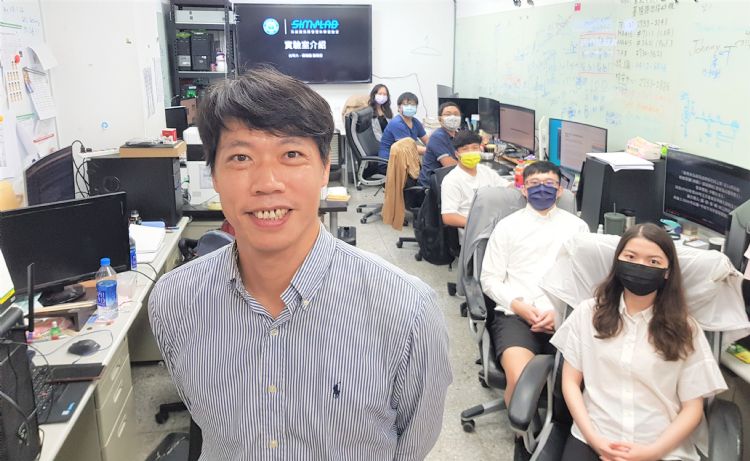Utilizing power of data to enhance corporate efficiency, Taiwan Tech's team demonstrates value of data with precision

Chao-Lung Yang from the Department of Industrial Management at Taiwan Tech with his team.
Photo: DIGITIMES
With the advent of the AI era, big data analysis has become the crucial technology for upgrades in various industries. However, physical equipment and online websites in both factory manufacturing lines and businesses, respectively, generate immense amount of data. Enterprises must strive to boost the operational efficiency by seeking ways to practically clean data to obtain the valuable information and to ensure strategies are made with more precision insight. Chao-Lung Yang from the Department of Industrial Management at National Taiwan University of Science and Technology (Taiwan Tech) and his team conducted in-depth research on big data analysis in different fields and scenarios and assisted enterprises across different industries to go through digital transformation with the aid of their research results.
Data analysis from Taiwan Tech's team can be divided into industrial application and commercial application. The industrial field went through an AI revolution under the wave of Industry 4.0. Smart manufacturing covers all kinds of fields. Particularly, the data extraction is the basis of all functions. For example, based on the extracted data from machines and sensors, the predictive maintenance function in equipment that many manufacturers were introduced is able to determine the future operating status of the equipment through data collection and analysis.
Daily amount of data generated by the production line is enormous and the system does not need to and cannot handle all of it. Therefore, it is necessary to filter out useful data in the front end in advance. Based on timing data analysis, Yang's team developed feature extraction and data compression algorithms to extract the useful information with relatively small data size. Data is first filtered at the front end of data extraction based on edge computing from a single machine to multiple machines. The data is then classified to different fields in the industrial Internet of Things, thereby lowering storage and computing costs for the entire system.
In addition to machine data analysis, Yang's team expanded timing data analysis to visual computing and image analysis. Yang stated that in most manufacturing plants, security surveillance cameras have been installed. The images obtained from these cameras can also be applied to different scenarios through analysis. One application would be to use AI modeling to analyze the images of working personnel and calculate the amount of work done and level completion in a certain amount of time or during the whole process. This way, one can estimate the personnel's work efficiency and standard working times to assist managers in controlling on-site working conditions. Another application would be to use human action/motion recognition to build an anti-collision early warning model for vehicles and machines. One can analyze the distance between a mobile machine and nearby personnel through image cameras and mmWave radar data. The model will sound the alarm when predefined security settings have been violated to reduce the chance of on-site accidents.
In the commercial field, data application is even broader. Yang's team conducted research on data from e-commerce platforms and social network platforms. He stated that the scale of e-commerce is growing at a rapid speed and is facing fiercer market competition. Enhancing the precision of product recommendation engines will boost sales for platforms and shops. Product recommendation engine data is mainly extracted from social websites. Data generated by social websites is incredibly immense, crucial data regarding balancing the remarks of opinion leaders and the voices of minority or disadvantaged groups is of great importance in social network analysis. The algorithm that Yang's team developed is to allow data to show a clearer picture as well as to save data analysis costs through measuring texts and keyword structures on social networks to improve the precision of data extraction via logic comparison in Internet structures. In addition, if there is missing data, the administrator can still trace back the data and improve the precision of product recommendation engines through comprehensive data analysis.
The industrial and commercial big data analysis technology developed by Yang's team is in collaboration with enterprises now, the technology is implemented to real-life cases and scenarios. Furthermore, the team continues to develop new technologies, including the use of visual computing to identify a personnel's workflow, detecting the sentiment expressions of the audience as reference for a movie's test screening. Most recently, applications have been expanded to the healthcare and medical field. Yang's team collaborated with Chang Gung University and used images to recognize the movements of the elderlies for data analysis to further enhance the quality of healthcare.
Yang indicated that research of these core technologies can truly assist business owners in the industrial, business and medical field. During technology research, assistance from the GLORIA project team is of great importance. Through the project, Yang's team is able to collaborate with various enterprises to develop algorithms with greater precision. Yang stated that for a science and technology university with robust technical capabilities, large enterprises are quite willing to collaborate with Taiwan Tech. GLORIA project is also the best mediator in between. Through the project, the direction of research and development of Yang's team can be closer to practical applications and obtain more resources and opportunities, this will have positive benefits for both industry and academia.
Article Extraction from DIGITIMES
https://www.digitimes.com/news/a20211011VL200.html
